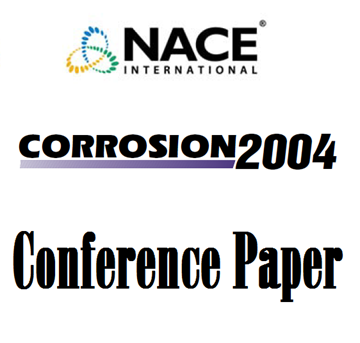Search
Products tagged with 'mic'
View as
Sort by
Display
per page
02446 MICROBIOLOGICALLY INFLUENCED CORROSION FAILURE ANALYSIS OF 304L STAINLESS STEEL PIPING SYSTEM LEFT STAGNANT AFTER HYDROTESTING WITH CITY WATER
Product Number:
51300-02446-SG
ISBN:
02446 2002 CP
Publication Date:
2002
$20.00
03060 HYDROGEN SULFIDE AND MICROBIOLOGICALLY INFLUENCED CORROSION OF CONCRETE, STEEL AND DUCTILE IRON IN WASTE WATER FACILITIES
Product Number:
51300-03060-SG
ISBN:
03060 2003 CP
Publication Date:
2003
$20.00
03544 MICROSCOPIC DIFFERENTIATION OF INTERNAL CORROSION INITIATION MECHANISMS IN NATURAL GAS PIPELINE SYSTEMS
Product Number:
51300-03544-SG
ISBN:
03544 2003 CP
Publication Date:
2003
$20.00
04758 Evaluation of an On-Line Biofilm Detector and Bio-Traps to Monitor MIC in Produced Oilfield Brine
Product Number:
51300-04758-SG
ISBN:
04758 2004 CP
Publication Date:
2004
$20.00
06516 EVALUATION OF ANTIFOULING COATINGS PERFORMANCE TO PROTECT CARBON STEEL AGAINST MIC AND BIOFOULING IN POLLUTED SEAWATER
Product Number:
51300-06516-SG
ISBN:
06516 2006 CP
Publication Date:
2006
$20.00
08174 Unusual Corrosion Failures of Stainless Steel in Low Chloride Waters
Product Number:
51300-08174-SG
ISBN:
08174 2008 CP
Publication Date:
2008
$20.00
08508 MIC in Fire Sprinkler Systems - Field Observations and Data
Product Number:
51300-08508-SG
ISBN:
08508 2008 CP
Publication Date:
2008
$20.00
10402 THPS Degradation in the Long-term Preservation of Subsea Flowlines and Risers
Product Number:
51300-10402-SG
ISBN:
10402 2010 CP
Publication Date:
2010
$20.00
11351 The Corrosion of Superduplex Stainless Steel in Different Types of Seawater
Product Number:
51300-11351-SG
ISBN:
2011 11351 CP
Publication Date:
2011
$20.00
51315-6083-Don’t Just Blame the SRBs and APBs for MIC
Product Number:
51315-6083-SG
ISBN:
6083 2015 CP
Publication Date:
2015
$20.00
51316-7034-Seawater Cooler Tubes: Corrosion And Leaks Due To Microbiologically Induced Corrosion
Product Number:
51316-7034-SG
ISBN:
7034 2016 CP
Publication Date:
2016
$20.00
51316-7109-Marine Crevice Corrosion Of Stainless Steel Alloys Under Biofilmed And Sterile Conditions
Product Number:
51316-7109-SG
ISBN:
7109 2016 CP
Publication Date:
2016
$20.00












